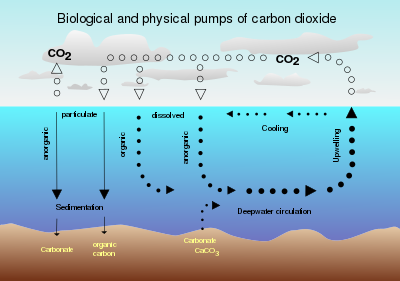
Back تغذية المحيط Arabic Eisendüngung German Fertilización del océano Spanish Ookeanide väetamine Estonian Fertilisation de l'océan French

2 sequestration in the ocean
Ocean fertilization or ocean nourishment is a type of technology for carbon dioxide removal from the ocean based on the purposeful introduction of plant nutrients to the upper ocean to increase marine food production and to remove carbon dioxide from the atmosphere.[1][2] Ocean nutrient fertilization, for example iron fertilization, could stimulate photosynthesis in phytoplankton. The phytoplankton would convert the ocean's dissolved carbon dioxide into carbohydrate, some of which would sink into the deeper ocean before oxidizing. More than a dozen open-sea experiments confirmed that adding iron to the ocean increases photosynthesis in phytoplankton by up to 30 times.[3]
This is one of the more well-researched carbon dioxide removal (CDR) approaches, and supported by the Climate restoration proponents. However, there is uncertainty about this approach regarding the duration of the effective oceanic carbon sequestration. While surface ocean acidity may decrease as a result of nutrient fertilization, when the sinking organic matter remineralizes, deep ocean acidity could increase. A 2021 report on CDR indicates that there is medium-high confidence that the technique could be efficient and scalable at low cost, with medium environmental risks.[4] The risks of nutrient fertilization can be monitored. Peter Fiekowsy and Carole Douglis write "I consider iron fertilization an important item on our list of pottential climate restoration solutions. Given the fact that iron fertilization is a natural process that has taken place on a massive scale for millions of years, it is likely that most of the side effects are familiar ones that pose no major threat" [5]
A number of techniques, including fertilization by the micronutrient iron (called iron fertilization) or with nitrogen and phosphorus (both macronutrients), have been proposed. Some research in the early 2020s suggested that it could only permanently sequester a small amount of carbon.[6] More recent research publlications sustain that iron fertilization shows promise. A NOAA special report rated iron fertilization as having "a moderate potential for cost, scalability and how long carbon might be stored compared to other marine sequestration ideas" [7]
- ^ Matear, R. J. & B. Elliott (2004). "Enhancement of oceanic uptake of anthropogenic CO2 by macronutrient fertilization". J. Geophys. Res. 109 (C4): C04001. Bibcode:2004JGRC..109.4001M. doi:10.1029/2000JC000321. Archived from the original on 4 March 2010. Retrieved 19 January 2009.
- ^ Jones, I.S.F. & Young, H.E. (1997). "Engineering a large sustainable world fishery". Environmental Conservation. 24 (2): 99–104. Bibcode:1997EnvCo..24...99J. doi:10.1017/S0376892997000167. S2CID 86248266.
- ^ Trujillo, Alan (2011). Essentials of Oceanography. Pearson Education, Inc. p. 157. ISBN 9780321668127.
- ^ National Academies of Sciences, Engineering (8 December 2021). A Research Strategy for Ocean-based Carbon Dioxide Removal and Sequestration. doi:10.17226/26278. ISBN 978-0-309-08761-2. PMID 35533244. S2CID 245089649.
- ^ Fiekowsky Peter, Douglis Carole (2022). Climate Restoration: the only future that will sustain the human reace. Rivertown Bools, Inc. p. 241. ISBN 978-1-953943-10-1.
- ^ "Cloud spraying and hurricane slaying: how ocean geoengineering became the frontier of the climate crisis". The Guardian. 23 June 2021. Archived from the original on 23 June 2021. Retrieved 23 June 2021.
- ^ "Is ocean iron fertilization back from the dead as a CO₂ removal tool?". 13 November 2023.